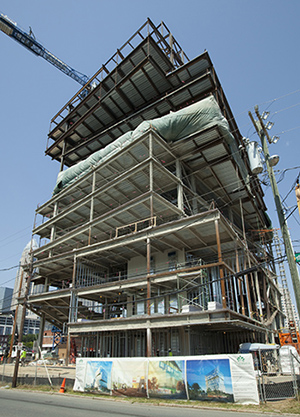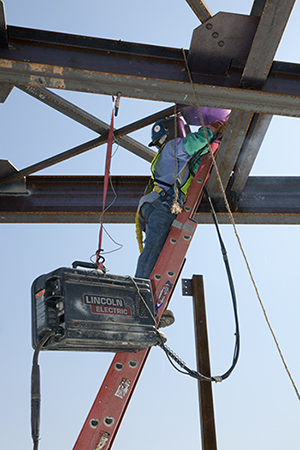Structural Steel Contractor Hits the Books for Building Unique Campus Addition
Structural steel contractor, Carolina Steel and Stone, literally hit the books to construct a 25 room, 143,000 square foot building, resembling a stack of books. Complete with classrooms, public space and faculty offices, the eye-catching Center City Building, designed by architectural firm, Kieran Timberlake, is located on the University of North Carolina’s campus in downtown Charlotte.
Carolina Steel and Stone, along with Rodgers Builders, was challenged with constructing the unique structure, requiring welding, with $45.8 million in public funds granted earlier this year from state lawmakers.
Modern Technologies for a Modern Design
Tim Davis, owner of Carolina Steel, brought on Bill Valentine, friend and welder, to review the company’s current welding process for constructing the distinctive academic building. Immediately, Valentine suggested switching from stick (SMAW), or manual welding process, to self-shielded, flux-cored welding (FCAW-S) for the structural steel project.
Valentine has over three decades of hands-on welding experience working with contractors. Over the years, he learned that self-shielded, flux-cored welding was a more efficient than stick welding for structural applications requiring large amounts of weld metal, such as moment connections and column splices. On many jobs throughout his career Valentine witnessed this process cutting the amount of manpower required in half.
With his experience using Lincoln Electric equipment and consumables, Valentine went straight to the local Lincoln Electric sales representative to help find a wire that was easy to use and met all the requirements of the job. Lincoln Electric’s Innershield® NR®-233 was a great option for training new welders and had smooth arc transfer for maximum puddle control.
Valentine also needed a welding consumable with higher impact properties to meet the requirements for the more demanding welds on the job. Desiring products that ran on the same polarity, he chose Innershield® NR®-311 Ni for its high impact properties – capable of exceeding 27 J (20 ft•lbf) at -29° C (-20° F) - and high deposition rates.
Both of his Lincoln Electric wire choices were AWS D1.8 lot tested and approved for seismic welding applications – a common requirement of structural steel jobs.
To qualify the welders for the job, he provided hands-on demonstrations and conducted welder training for two days before the welders took their tests. With a better-than-average passing rate, more than 75 percent of the company’s welders passed on the first try.
Improving Productivity for an Updated Campus
From the beginning, Valentine was able to cut the number of welders required for the 12-story job from eight down to three. As they began welding, the company saw productivity increase immediately. The easy slag removal on the Innershield® deposits reduced clean-up time.
“I’ve been in the welding industry for 35 years, and I will only use Lincoln products,” Valentine commented. “The wire is well worth the cost. The quality in the finished weld is what you really look for, and with Innershield®, wire rejects are rare.”
According to Valentine, the time savings allowed the welders to move rapidly on the project, putting the team four weeks ahead of schedule. Overall the company yielded 30 percent in cost savings and increased welding efficiency.
“The switch from a stick electrode to wire reduced the amount of time required for welding by at least one full week and resulted in putting the crew four weeks ahead of schedule,” said Valentine.
Delivering a Solid Solution for Education
Valentine played an integral role in the company’s ability to take on such a large and unique project. This educational building continues to make a statement in this academic community in North Carolina.


